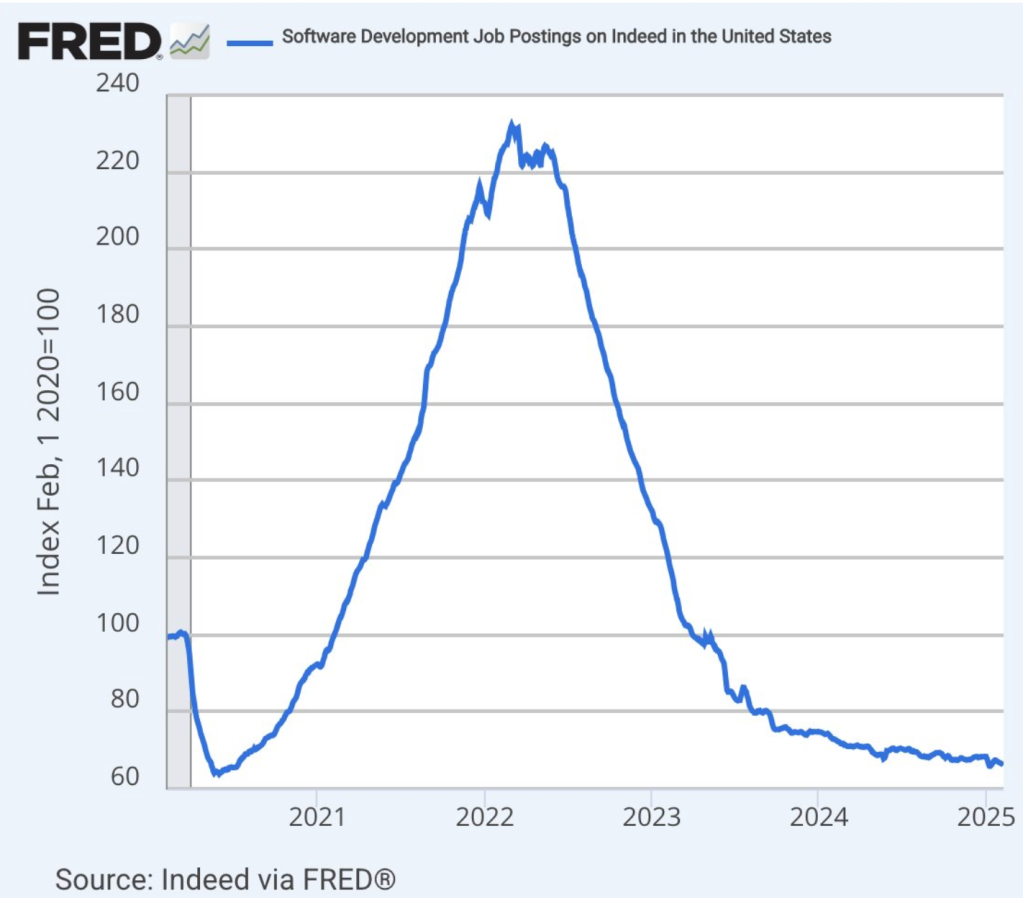Former Labor Secretary Ray Marshall described the H-1B visa program as “one of the best con jobs ever done on the American public and political systems.” That might explain why it has survived this long. Despite more and more Americans across the political spectrum demanding change, the H-1B program continues unabated. If anything, the program has slightly expanded after a last minute change from the outgoing Biden administration. Registration for the H-1B lottery (yes, another lottery to randomly give away U.S. jobs) opened up last week; business as usual.
There is no labor shortage for the H-1B program to address. Software development jobs are down 70 percent from their peak. Unemployment in the technology sector has surged with more companies like Meta planning layoffs (and Americans who have left the field to find work in other industries aren’t counted in the unemployment statistics), yet tech companies dominate H-1B approvals. Over 400,000 Americans graduate with STEM degrees every year but even the best of the best are having trouble landing jobs in their area of study. None of this is new. By the 2000s, colleges and universities were graduating more than twice the number of STEM graduates (Bachelor’s, Master’s, and Ph.D.’s) as there were expected jobs.

The H-1B visa was created in 1990. Supporters claimed it would serve to fill temporary labor shortages primarily in STEM fields while the American education system could start to produce sufficient domestic workers of our own. That was the cover story, at least. The National Science Foundation had been clamoring for expanded immigration to hold down salaries. Congress complied, first with the H-1B program in 1990, followed by the OPT program shortly thereafter. The F1-OPT-H1B pipeline has fulfilled the desire for cheaper workers, and then some.
Foreign students use the F-1 visa to gain access to the U.S. labor market. As the no-longer-active H1visajobs.com once explained, students look for “an employer willing to offer a job on OPT (Optional Practical Training) followed by STEM extension and sponsorship for H-1B visa.” Under this system, universities are no longer selling education but access to the U.S. labor market; and citizenship. Unsurprisingly, demand is high. The U.S. issued 400,000 student visas in FY2024.
In his tour-de-force article for Compact Magazine, H-1B watchdog Professor Norman Matloff rips the cover story off of the sorded H-1B narrative history, stating plainly: “The H-1B program was deliberately set up to hire younger, cheaper foreign workers in lieu of older, more expensive Americans.“
“The National Science Foundation is a major government funder of university research—and one force behind the rise of H-1Bs. Lower salaries give the agency more bang for its buck, and a 1989 internal memo—written the year before enactment of the H-1B program—was quite blatant in promoting the use of cheap foreign labor to that end. It called for stepping up recruitment of foreign doctoral students, using eventual attainment of a US green card as a lure. It also forecast—correctly—that lower wages would discourage domestic students from pursuing a doctorate. ‘A growing influx of foreign PhDs into US labor markets will hold down the level of PhD salaries,” the report said. For domestic students, it noted, “the effective premium for acquiring a PhD may actually be negative.'”
Things have played out more or less as the National Science Foundation foresaw. Matloff argues that most analyses (including, probably, my own) of the H-1B program underestimate the negative impacts because they don’t count former H-1B holders.
“A more accurate measure,” Matloff suggests, “is the percentage of international students in US tech graduate programs, which has skyrocketed over the years.” Three out of four computer science graduate students today are foreign.
There was never any truth to the “jobs Americans can’t do” argument. This is and always was about cheap, controllable labor. The tragic irony is if we don’t move Congress to limit H-1B to a small number of exceptional talents, the legacy of the H-1B program will be to drive Americans completely out of these occupations.
“The current job market is abysmal,” continues Matloff, “and many college students have seen their parents, aunts and uncles and other elders fall victim to the industry’s age discrimination problem. Given these headwinds, many potential tech students will naturally gravitate to other fields.”
What will it take to spur Congress to correct this self-defeating con job?